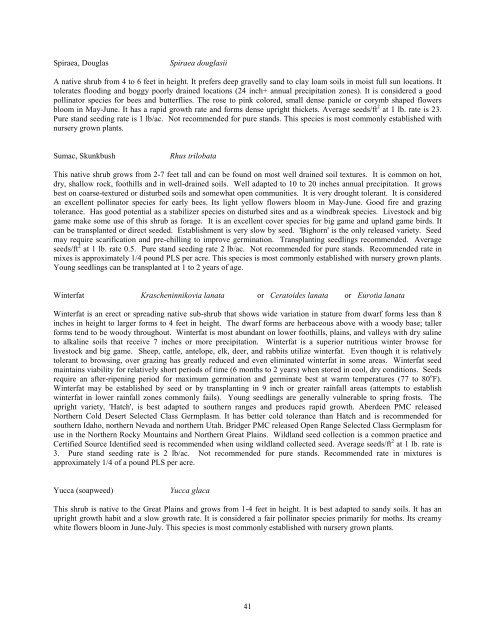Idaho Plant Materials Technical Note No. 24
Idaho Plant Materials Technical Note No. 24
Idaho Plant Materials Technical Note No. 24
You also want an ePaper? Increase the reach of your titles
YUMPU automatically turns print PDFs into web optimized ePapers that Google loves.
Spiraea, Douglas<br />
Spiraea douglasii<br />
A native shrub from 4 to 6 feet in height. It prefers deep gravelly sand to clay loam soils in moist full sun locations. It<br />
tolerates flooding and boggy poorly drained locations (<strong>24</strong> inch+ annual precipitation zones). It is considered a good<br />
pollinator species for bees and butterflies. The rose to pink colored, small dense panicle or corymb shaped flowers<br />
bloom in May-June. It has a rapid growth rate and forms dense upright thickets. Average seeds/ft 2 at 1 lb. rate is 23.<br />
Pure stand seeding rate is 1 lb/ac. <strong>No</strong>t recommended for pure stands. This species is most commonly established with<br />
nursery grown plants.<br />
Sumac, Skunkbush<br />
Rhus trilobata<br />
This native shrub grows from 2-7 feet tall and can be found on most well drained soil textures. It is common on hot,<br />
dry, shallow rock, foothills and in well-drained soils. Well adapted to 10 to 20 inches annual precipitation. It grows<br />
best on coarse-textured or disturbed soils and somewhat open communities. It is very drought tolerant. It is considered<br />
an excellent pollinator species for early bees. Its light yellow flowers bloom in May-June. Good fire and grazing<br />
tolerance. Has good potential as a stabilizer species on disturbed sites and as a windbreak species. Livestock and big<br />
game make some use of this shrub as forage. It is an excellent cover species for big game and upland game birds. It<br />
can be transplanted or direct seeded. Establishment is very slow by seed. 'Bighorn' is the only released variety. Seed<br />
may require scarification and pre-chilling to improve germination. Transplanting seedlings recommended. Average<br />
seeds/ft 2 at 1 lb. rate 0.5. Pure stand seeding rate 2 lb/ac. <strong>No</strong>t recommended for pure stands. Recommended rate in<br />
mixes is approximately 1/4 pound PLS per acre. This species is most commonly established with nursery grown plants.<br />
Young seedlings can be transplanted at 1 to 2 years of age.<br />
Winterfat Krascheninnikovia lanata or Ceratoides lanata or Eurotia lanata<br />
Winterfat is an erect or spreading native sub-shrub that shows wide variation in stature from dwarf forms less than 8<br />
inches in height to larger forms to 4 feet in height. The dwarf forms are herbaceous above with a woody base; taller<br />
forms tend to be woody throughout. Winterfat is most abundant on lower foothills, plains, and valleys with dry saline<br />
to alkaline soils that receive 7 inches or more precipitation. Winterfat is a superior nutritious winter browse for<br />
livestock and big game. Sheep, cattle, antelope, elk, deer, and rabbits utilize winterfat. Even though it is relatively<br />
tolerant to browsing, over grazing has greatly reduced and even eliminated winterfat in some areas. Winterfat seed<br />
maintains viability for relatively short periods of time (6 months to 2 years) when stored in cool, dry conditions. Seeds<br />
require an after-ripening period for maximum germination and germinate best at warm temperatures (77 to 80 o F).<br />
Winterfat may be established by seed or by transplanting in 9 inch or greater rainfall areas (attempts to establish<br />
winterfat in lower rainfall zones commonly fails). Young seedlings are generally vulnerable to spring frosts. The<br />
upright variety, 'Hatch', is best adapted to southern ranges and produces rapid growth. Aberdeen PMC released<br />
<strong>No</strong>rthern Cold Desert Selected Class Germplasm. It has better cold tolerance than Hatch and is recommended for<br />
southern <strong>Idaho</strong>, northern Nevada and northern Utah. Bridger PMC released Open Range Selected Class Germplasm for<br />
use in the <strong>No</strong>rthern Rocky Mountains and <strong>No</strong>rthern Great Plains. Wildland seed collection is a common practice and<br />
Certified Source Identified seed is recommended when using wildland collected seed. Average seeds/ft 2 at 1 lb. rate is<br />
3. Pure stand seeding rate is 2 lb/ac. <strong>No</strong>t recommended for pure stands. Recommended rate in mixtures is<br />
approximately 1/4 of a pound PLS per acre.<br />
Yucca (soapweed)<br />
Yucca glaca<br />
This shrub is native to the Great Plains and grows from 1-4 feet in height. It is best adapted to sandy soils. It has an<br />
upright growth habit and a slow growth rate. It is considered a fair pollinator species primarily for moths. Its creamy<br />
white flowers bloom in June-July. This species is most commonly established with nursery grown plants.<br />
41
















